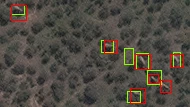Satellites have offered scientists a powerful new tool when it comes to tracking endangered wildlife, with the movements of tagged animals able to be monitored with great precision. A new technology promises to expand the possibilities even further, with scientists demonstrating a new computer algorithm that can be used to track untagged animals in complex landscapes via satellite imagery for the first time.
The breakthrough is the result of a collaboration between scientists at the University of Bath, the University of Oxford and the University of Twente, with the team using the largest land animals on Earth as their starting point, endangered African elephants. These creatures can meander through exposed grasslands, covered woodlands and anything in between, so using satellite imagery to spot them from space presented some unique challenges.
“This type of work has been done before with whales, but of course the ocean is all blue, so counting is a lot less challenging,” says Dr Isupova. “As you can imagine, a heterogeneous landscape makes it much hard to identify animals.”
Computer scientists at the University of Bath created a deep learning algorithm that can scan satellite images of vast areas of land in minutes, detecting the elephants with the same accuracy as human observers in low-flying aircraft. The team says this is the first technology to reliably monitor animals moving through a heterogenous landscape using satellite imagery, which could prove valuable to conservationists in a number of ways.

Not needing to tag the animals first means that the creatures don’t need to be disturbed and humans don’t need to be placed in danger. It also makes it easier for endangered populations to be monitored as they migrate across international borders, circumventing issues like border controls or conflict between countries.
Wildlife numbers are declining at an alarming rate, with as much as two thirds of wildlife populations of the Earth’s vertebrate species lost since 1970 as a result of human activity. Suffice to say, conservationists need all the help they can get when it comes to reversing this trend and preserving the world’s endangered animals. While elephants were used in these initial phases of the research, the scientists hope that as the technology improves, it can be leveraged to monitor animals much smaller in size.
“Satellite imagery resolution increases every couple of years, and with every increase we will be able to see smaller things in greater detail,” says Dr Olga Isupova from the University of Bath. “Other researchers have managed to detect black albatross nests against snow. No doubt the contrast of black and white made it easier, but that doesn’t change the fact that an albatross nest is one-eleventh the size of an elephant.”
The research was published in the journal Remote Sensing in Ecology and Conservation.
Source: University of Bath




